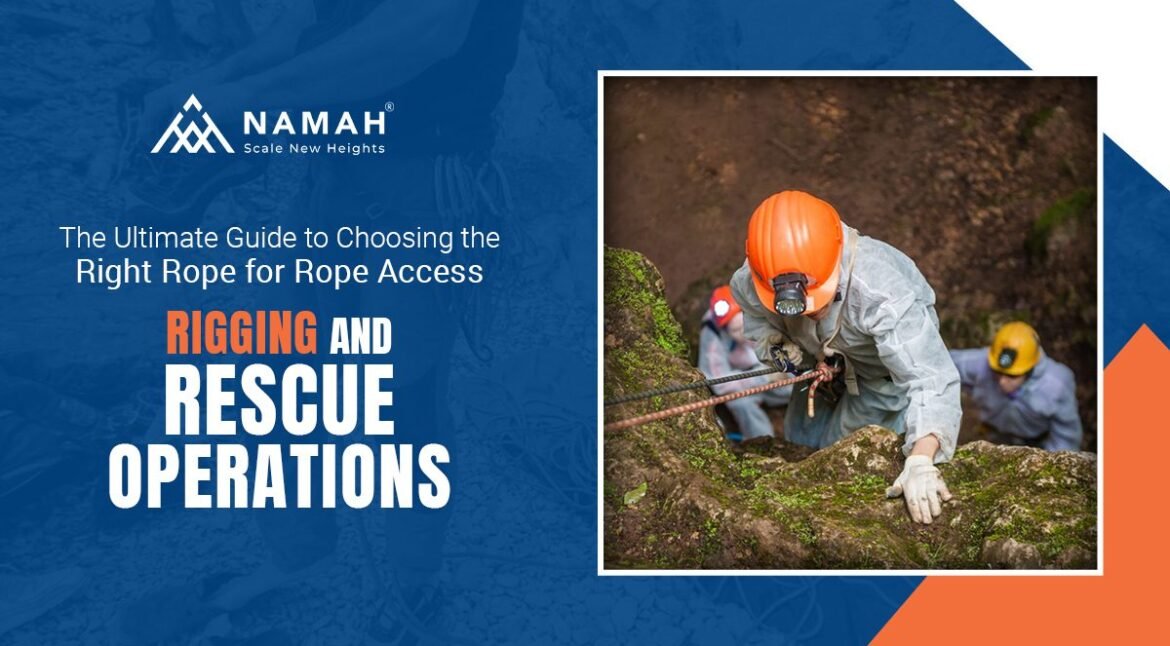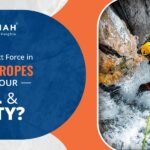When it comes to rope access, rigging, and rescue operations, the rope you choose isn’t just a tool it’s a lifeline. Whether you’re scaling tall buildings for construction, securing heavy loads in rigging, or saving lives during a rescue mission, the right rope can make all the difference between success and disaster. It’s easy to overlook the importance of selecting the right rope, but when you’re in a situation where lives are on the line, every detail counts.
Rope access and rigging work can be hazardous, and rescue missions are often unpredictable, so choosing a rope that meets your needs and adheres to safety standards is critical. But how do you go about selecting the right rope when there are so many options available on the market? The key lies in understanding several critical factors, including the material, construction, strength, diameter, and certifications of the rope.
In this ultimate guide, we will break down these key considerations and provide you with expert insights into choosing the best rope for your operations whether for rope access, rigging, or rescue work.
1. Why Rope Material Matters More Than You Think
Rope material is one of the most important factors to consider when selecting the right rope. The material determines the rope’s strength, flexibility, resistance to wear and tear, and its ability to handle dynamic loads. For high-stakes operations such as rescue missions or climbing, using the right material can make all the difference. The two most common materials for professional ropes are nylon and polyester, each of which has its own distinct advantages depending on the type of work being done.
Nylon Ropes: The Shock Absorbers
Nylon ropes are known for their elasticity, which allows them to absorb sudden shocks. This makes them ideal for dynamic operations such as:
- Rescue Operations: In rescue missions, particularly in high-risk situations such as rescuing people from heights, falls are often inevitable. Nylon’s shock-absorbing properties help minimize the impact force on the individual and the rescuer.
- Rope Access & Climbing: When climbing or performing rope access, nylon ropes help reduce the impact force on both the climber and the equipment in the event of a fall, ensuring a smoother experience.
While the elasticity of nylon is beneficial for these applications, it can also pose a disadvantage in other situations. The stretchiness of nylon may not be ideal in applications that require precise control, such as rigging or high-precision tasks, where too much movement can lead to destabilization.
Polyester Ropes: The Durable Workhorses
Polyester ropes, on the other hand, are known for their low stretch, which provides greater stability and reliability in specific tasks. These ropes are especially useful for applications that involve heavy loads, long-term exposure to harsh elements, or situations that require minimal rope elongation. Some key benefits of polyester ropes include:
- Rigging: In rigging, where loads must remain fixed and there’s no room for elasticity, polyester ropes are often the best option. The low stretch ensures minimal elongation and better control.
- Long-Term Outdoor Use: Polyester ropes offer excellent resistance to UV rays, water, and abrasion, making them an ideal choice for long-term outdoor exposure. Their durability makes them a great option for operations that take place in challenging environmental conditions, such as construction and industrial applications.
Polyester ropes are perfect for situations where stability and durability are key, and their minimal stretch is ideal for heavy-duty applications.
2. Rope Construction: Kernmantle vs. Braided
The construction of the rope affects its performance, strength, and handling. When choosing the right rope for your operation, understanding the differences between kernmantle ropes and braided ropes will help you make an informed decision.
Kernmantle Ropes: The Gold Standard for Safety
Kernmantle ropes are constructed with a strong inner core (the kern) that provides the rope’s strength, while the outer sheath (the mantle) serves as protection from external wear and tear.
- Why They’re the Best: Kernmantle ropes are considered the gold standard for rope access, rescue operations, and climbing because they offer an ideal balance of strength, durability, and smooth handling. The outer sheath protects the inner core from abrasion, UV rays, and moisture, while the core ensures the rope can withstand heavy loads and dynamic forces.
- Safety Considerations: Kernmantle ropes are designed for high-risk, life-critical situations, making them the go-to choice when safety is non-negotiable. Their smooth construction and durability make them ideal for operations where a rope’s reliability is paramount.
Braided Ropes: Flexible but Less Robust
Braided ropes are made by intertwining multiple fibers, which gives them a flexible and soft texture.
- Why They’re Used: While braided ropes are flexible and easy to handle, they are typically best suited for non-life-critical applications such as towing, general-purpose rigging, and light-duty tasks. They offer a softer feel and are more adaptable to various situations, but they don’t offer the same strength-to-weight ratio as kernmantle ropes.
- Drawbacks: Braided ropes lack the internal core found in kernmantle ropes, which means they don’t have the same strength or durability. They also have a lower resistance to abrasion and environmental damage.
While braided ropes are useful for light-duty operations, they are not recommended for high-risk or life-critical tasks like rope access or rescue missions.
3. Breaking Strength & Diameter: How Much Load Can Your Rope Handle?
Understanding a rope’s breaking strength and diameter is crucial for ensuring the rope can handle the loads required in your operations. Breaking strength is measured in kilonewtons (kN) and indicates how much force the rope can take before it fails.
- Minimum Strength: For single-rope use, a breaking strength of at least 20 kN is typically recommended. This is adequate for most general tasks, such as light rope access or climbing.
- Heavy-Duty Requirements: For operations that require greater strength, such as rescue operations, industrial rigging, or situations involving heavy loads, a rope with a breaking strength of 30 kN or higher is ideal.
Rope Diameter: Thicker vs. Thinner
Rope diameter impacts not only strength but also the rope’s weight, flexibility, and ease of handling. Here’s what to consider:
- Thicker Ropes (10-12mm): These ropes are stronger and capable of supporting heavier loads. However, they tend to be heavier and more challenging to handle, which can affect their maneuverability, especially in tight spaces.
- Thinner Ropes (8-10mm): Thinner ropes are lighter and more flexible, making them easier to handle and maneuver, particularly for activities like climbing and rope access. However, they may not support the same heavy loads as thicker ropes.
The right diameter for your rope depends on your specific needs. If you require higher strength for industrial rigging, thicker ropes will be necessary. But for tasks that require more agility, like rope access or climbing, thinner ropes are more suitable.
4. Certifications: Why They Matter
Certifications are an essential part of the selection process. They ensure the rope has undergone rigorous testing to meet industry safety standards. The following certifications should be looked for:
- CE Marking: This certification ensures that the rope meets European safety standards.
- UIAA Certification: This certification is important for climbing ropes, as it ensures the rope meets the standards for dynamic loads in climbing and mountaineering.
- NFPA/ANSI Compliance: Ropes used in rescue operations, firefighting, and other life-saving applications should be compliant with NFPA (National Fire Protection Association) or ANSI (American National Standards Institute) standards to ensure the rope meets safety requirements.
Certified ropes are rigorously tested for:
- Strength under load: Ropes are tested to ensure they can withstand high loads without breaking.
- Resistance to abrasion, UV, and moisture: Ropes undergo tests to check how well they resist wear and environmental damage.
- Performance in extreme conditions: Ropes are also tested for their performance in extreme temperatures, humidity, and exposure to chemicals.
Safety should always be your top priority, so never compromise on the certifications of your ropes.
5. Matching the Right Rope to Your Job
The right rope for your job depends on the specific tasks you’re performing. Here’s a breakdown of which ropes are best suited for different applications:
- Rope Access (Construction, Maintenance, Climbing): For rope access and climbing, the best choice is polyester or nylon kernmantle ropes (10-11mm). These ropes provide low stretch for better control and high strength to ensure safety.
- Rigging (Industrial, Stage, Heavy Loads): When it comes to rigging, especially in industrial environments or for securing heavy loads, polyester kernmantle or static ropes (11-12mm+) are ideal. These ropes offer minimal stretch and high abrasion resistance, making them suitable for long-term use in challenging environments.
- Rescue Operations (Firefighting, Mountain Rescue): For rescue operations, including firefighting and mountain rescue, UIAA-certified nylon kernmantle ropes (10-11mm) are the top choice. Their shock-absorbing capabilities and durability under extreme conditions make them essential for life-saving applications.
Final Thoughts: Safety First, Always
Choosing the right rope is more than just a technical decision; it’s about ensuring your safety and the safety of others when performing high-risk tasks. Always consider the material, construction, strength & diameter, and certifications when making your choice.
At Namah Ropes, we understand the importance of having the best gear for your work. That’s why we engineer ropes that meet the highest safety standards, ensuring professionals like you can trust their equipment in even the most demanding situations.
If you’re ready to explore our range of high-performance ropes that deliver superior performance and safety, visit us today at Namah Ropes and find the perfect rope for your next operation.
Stay safe, and let’s keep climbing to new heights of safety and performance.




